|

| |

The FRAM's route from the Beagle channel,
through the Drake Passage down to the Southern Shetland Islands and then the
Antarctic Peninsula
NEWS FROM THE DEEP SOUTH...
NOTE: Also this time I chose to tell the story of the voyage using the mails
that I sent to friends and family during the voyage itself. The
story started when we were already sailing south towards Antarctica, briefly
summarizing the previous events.
9/dec/2010
I try to send this e-mail using the ship's onboard system: judging from the
connection speed, you would think they hand the messages to passing storm
petrels for delivery ashore....
All started with one disappointment and a half: the half disappointment was the
trip to Chile's National Park of Torres del Paine: spectacular mountains, if you
could see them.... We had rain instead, strong winds and the mountain peaks
barely visible in the mist!
....and on top of that, the 450 Km back and forwards through the EMPTY
Patagonian plains, with nothing to see...
The full disappointment: 3 days ago we wake up at 4 in the morning to land (by
special permit) on Isla Margarita where we could visit a colony of Magellanic
Penguins. Two hours of preparation and then the wind increases and the
landing is cancelled!! Very disappointed, we leave the island
heading west along the Magellan Channel, one of the two shortcuts connecting the
Atlantic and Pacific sides of Tierra del Fuego and Patagonia, while the wind
rises to 75 knots!!!
After that, luckily things start getting better: we take a shortcut between the
Magellan and Beagle Channels, and sail along a series of spectacular glaciers
coming down to the sea which keep us on deck for hours on end, then yesterday
the ship drops anchor in front of Isla de Hornos, the legendary Cape Horn!
Weather conditions are "good" (more or less...) and we are allowed to go ashore
on Cape Horn!! (see the full story on THIS
PAGE).
We landed on the island and climbed up to the lighthouse where we signed the
visitors' book before heading to the monument to all mariners, representing an
albatross in flight.
We leave again, and after having doubled Cape Horn (just for the sake of it,
there was no need as we are heading south-southeast) we start feeling the seas
of the southern ocean.

Cape Horn seen from FRAM's stern while heading
south
Tomorrow we should land at Deception Island, where there is an
abandoned whaling station.
10/dec/2010
After having earned (well, more or less...) the right to wear an ear ring at the
left ear (I think...) to show that we doubled Cape Horn, and after nearly two
days sailing with increasingly tall waves, we reached Deception
Island, a sort of antarctic Santorini because both islands are in fact the
caldera rim of a still active volcano, flooded by the sea so you can (carefully)
get inside with the ship.
From the beginning of the 19th Century and until the 1930's a whaling station
was operated here; you can still see the now-collapsing buildings, old, rotting
wooden boats and the big cauldrons where whales (and reportedly also penguins)
were boiled by the thousands to extract oil.
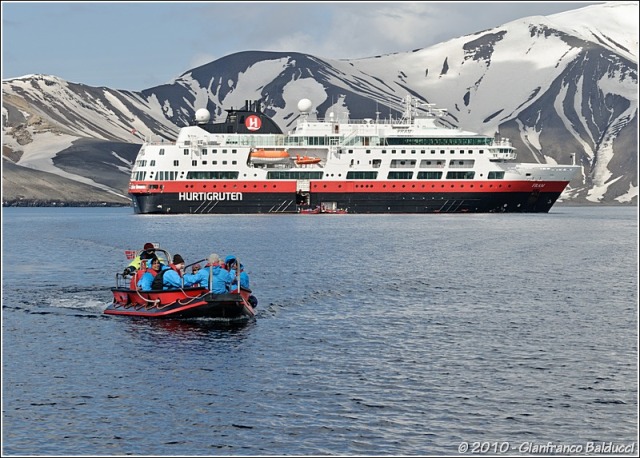

We disembark from the ship, anchored in Deception Island's caldera, in a
well-sheltered cove where the old whaling station was located


The collapsing remains of the whaling station and our first penguins!
("Chinstrap" penguins, in this case)
For us the main attraction are the penguins: actually there
are not many, there is no hatching colony on this island, just few dozen
un-mated youngsters which take life easily in the relatively mild summer
climate, not bothering hatching eggs or feeding newborn chicks.
For the first time we get in touch with these birds-that-don't-look-like-birds;
here there are two species (out of a total of 18) the "gentoo" and the "chinstrap",
both not very large (the Emperor penguins, which are much bigger and reach 1
meter height, live far to the south and we will not be able to see them).
They do not seem bothered by our presence, in fact quite often they come close
to watch these funny blue penguins (us, wearing standard-issue blue jackets),
but most of the time they just stand there doing nothing or scratching their
feathers.
A short passage takes us to Livingston island, where we meet a herd of
sea-elephants (a sort of sea lion): huge beasts which can weigh up to 3 tons,
and quite aggressive! They ive in harems with up to 100 females and
only one male which obviously is quite busy defending his territory, but also
the females appear quite litigious for some unknown reason.

A big male Sea Elephant has something to
complain about with a female...


(left) Baby pretends to be a Sea Elephant and (right) a "gentoo" penguin walking
around
Now we are waiting for the last group to come back aboard and
then we will leave, don't know yet to which destination: here the detailed
program is dictated by weather conditions!
In the meantime a small iceberg floats by, pushed by the wind: 7 or 8 penguins
are hitching a ride on it through the oceans...

Adelie penguins hitching a ride on an iceberg
12/dec/2010
Can you visualize a penguin? Remember, one of those cute little
bird-like animals, walking around flapping their useless wings and always
looking very busy?
Now, try to visualize 2 of them, then 3, then 4 and up, up to TWO HUNDRED
THOUSAND of them on a little island, all busy taking turns hatching their lonely
egg, while the Skuas, nasty-looking predator birds, wait for the split-second
opportunity to snatch an egg and eat it.

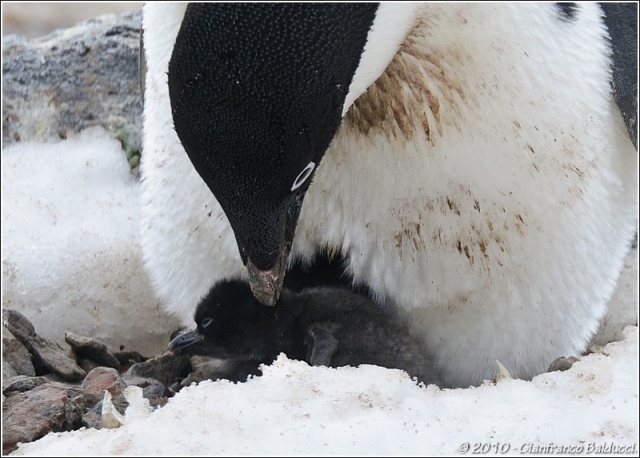

Adelie penguins busy hatching their egg or taking care of the newborn chick

Two Skuas laughing out loud....
And then, it's not enough to call them penguins, there are the
Adelie, the Gentoo, the Chinstrap and many other species that we will not see...
but those we see, we see them in large numbers, all busy making their nest (a
nest of pebbles, there are no branches here around) and then laying and hatching
their one or two eggs (depending on the species); both male and female take
turns, while the other goes to the sea for food.
And in the meantime, they loose a lot of poo!!! There's penguin s**t
everywhere, they say that a penguin colony can be smelled from miles away!
Back on board, the ship heads towards the Antarctic Channel, a sort of "iceberg
alley", towards Paulette Island and its penguin colony, which are on the other
side of the Antarctic Peninsula, in the Weddell sea; soon the sea starts being
covered in ice floes until it's almost fully covered, and the ship plays ice-breaker,
hitting the pack head-on, until a larger piece of ice doesn't give up and we
have to retreat, take aim and push the ice to one side!


FRAM sails carefully in the Bransfield channel, where we meet another ship
going in the opposite direction
Often we can see penguins on the ice, and even some Leopard
Seals (which eat penguins for breakfast!); most of the times they do not care
about our ship passing-by, unless we hit their ice floe, in which case they dive
quickly.

Another landing to see a penguin colony and then away to the
south.
The sea is littered with icebergs, large and small, but for the moment there is
plenty of water in-between and we can sail fast.
Next stop tomorrow afternoon, more than 200 miles more to the south of our
current position.
12/dec/2010
11 PM, time to go to bed, a quick look out of our cabin's porthole, and there is
a HUGE iceberg just passing by, maybe 15 or 20 meters from the ship! We look
towards the bow, and there's another iceberg approaching.
OK, understood: jacket, wooden cap, camera and up on deck: it's not like this
morning with the sea covered by ice floes, but all around us there are icebergs,
most just flat and with vertical sides, but older ones have taken all possible
odd shapes.
The Captain is zig-zagging among the icebergs: I can figure him seated at the
helming station, with 7 radar screens in front of him, while he steers the ship
with the tip of one finger on a small joystick! The old-fashioned rudder wheel does
is nowhere to be seen, times have changed quite a lot since when the first explorers were
coming this way a couple of centuries ago!



We end-up staying on deck until after midnight, watching the
show of the blue icebergs on the backdrop of far-away snow-covered mountains
just coming out of the water.
I forgot: midnight, but not dark: bathtub-blue icebergs stand out against the
orange light of the setting sun on the faraway mountains.
It never gets dark, by 3 a.m. the sun will rise again lighting an extraordinary
view.
2 hours spent on deck watching the scenery and taking photos, and when I go down
Baby asks: "did you see the whales"?? What, which whales?? 2
hours on deck and I didn't see one!!! I just look out of the lounge's windows, and
there it is, the tail of a whale, just diving now!!! Damn.....!
Afternoon, another landing to see another penguin colony: this time the ground
is covered in snow, about one meter high and very soft, so walking around is
very difficult, we keep sinking all the time. The penguins instead
keep coming and going, and this way they have dug trenches in the snow: every
now and then you see a penguin's head going towards the sea or just coming back
after lunch.
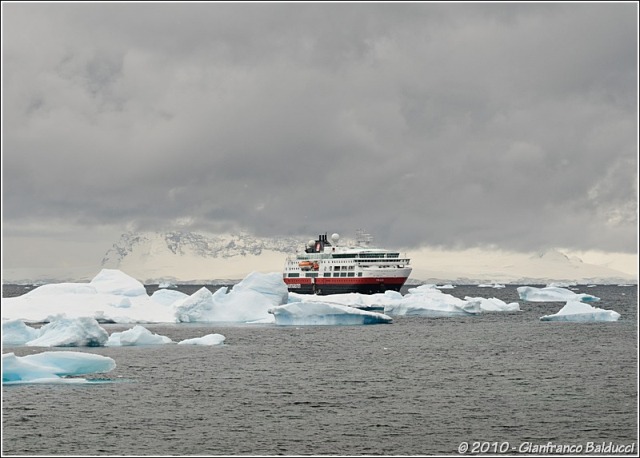
FRAM at anchor in front of Cuverville island


After a lot of back-and-forwards trips, penguins have dug these trenches that
they use to reach the sea
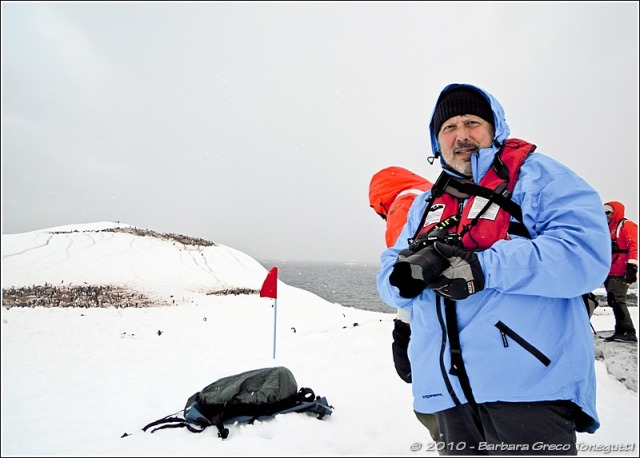
A perfect Polar-Explorer outfit!...
I stop typing for an instant, look outside, and an iceberg
goes by, perhaps less than 10 meters away: I must stop this mail and rush on
deck!!!
13/dec/2010
65 degrees, 5 minutes south, quite close to the Antarctic Polar Circle, this is
the lowest latitude we are going to reach during this trip; we were supposed to
reach a bit farther south, at 65 and 25, and in order to do that we were
supposed to go through the Lemaire channel, a narrow and spectacular stretch of
sea flanked by steep mountains.

Sailing towards the entry of the Lemaire
channel, where we will be forced to turn back due to the ice
Around 23 p.m. yesterday night, we entered the channel mouth,
in an eerie atmosphere due to the fog revealing the nearby hills like white
shadows, barely visible despite they were just few hundred meters away from each
side of the ship.
Forward on tip-toe then, zig-zagging at a very low speed through ice floes and
the occasional iceberg, while falling snow added a touch of drama to the scene.
Then, all of a sudden, just when the channel outer end was in sight, the Captain
turned the joystick and reversed the ship: the ice-pack in front of us was thick
and solid, too tough for us (the ship has a reinforced hull but is not a true
icebreaker).
Even our retreat was not easy, because the ice was already closing at out back,
and it took quite some doing to get out of the channel. We were
perversely beginning to hope being blocked there for a while just like an Amundsen or Shackleton,
but the captain with his joystick in the end has made it!

In the Lemaire channel, the ice is nearly
solid, too dangerous for our little ship!
This morning another premiere, the sun!! Instead of visiting
the Ucrainean scientific base, which remains at the other end of the Lemaire
channel, we anchored in Neko Harbour, a deep inlet surrounded by snowy peaks,
where we once again had to walk through waist-deep snow to see just another
penguin colony, but at least this time the sun is giving an entirely new light
to the scenery.

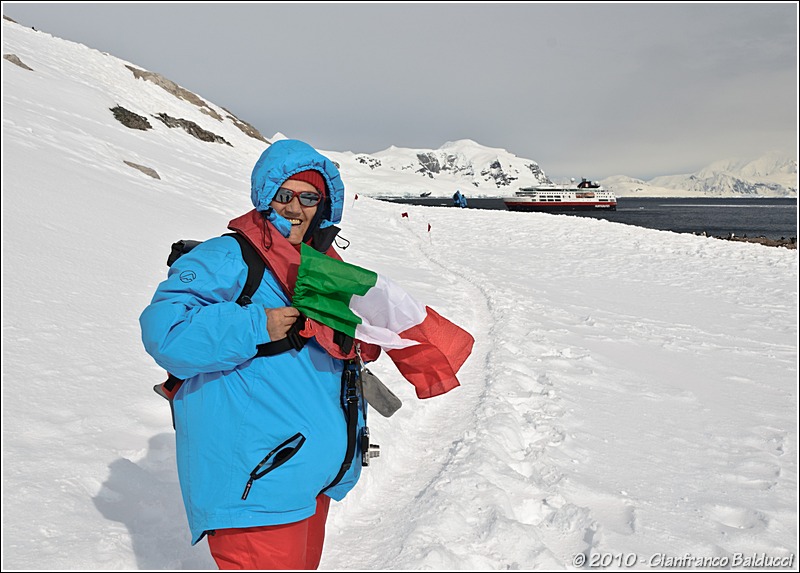
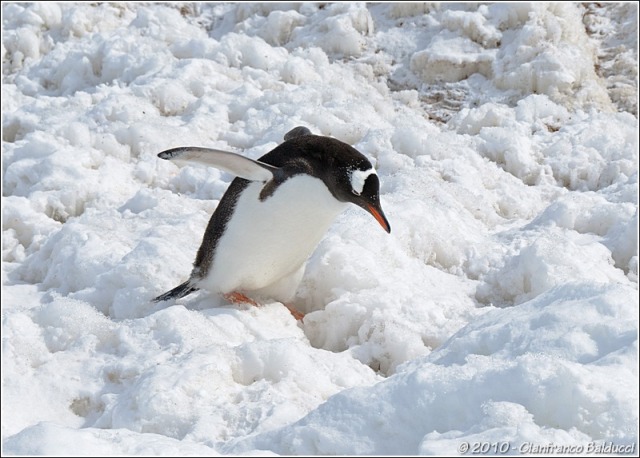
(Left) Baby plays the explorer of old times and (right) a Gentoo penguin has his
trouble walking on the upturned snow
Gone again, this time towards the west, to go and visit the
southernmost museum in the world, the old British Base "A", built during WW2 to
monitor German activity and abandoned in the '60's. About 15 years
ago an historical Society has restored the base which is now a museum that can
be visited during the short summer months. 3 wardens live in the base
and manage the small souvenir shop and the Post Office (!) which handles over 70.000
postcards every year, sent everywhere around the world.

The fantastic scenery of the Neumaier channel,
going towards Port Lockroy


One of the buildings of the British Antarctic Base "A" and the
interior of one of the rooms, now converted into a museum
Postcards may take up to two months before delivery, please be
patient!
Our return trip to the ship was particularly "wet" due to the strong wind, we
climbed out of the RIB completely soaked by icy seawater.
Now the ship has just weighed anchor: we do not know yet our next destination,
we will be told in about one hour.
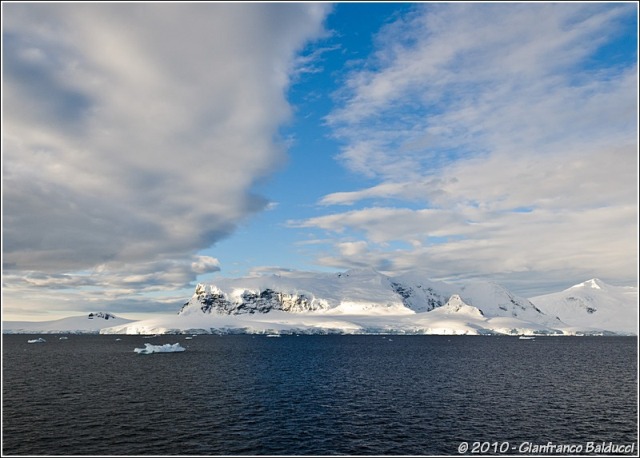
The voyage is coming to an end, but we will have one last
glorious day tomorrow!!
15/dec/2010
Today we have come a bit to the north, to the so-called "Southern Shetland"
islands, where we stopped already at the beginning of this voyage at the end of
the world. Two easy stops, graced by good weather and sun, which was notably
absent during the outgoing leg.
ICEBERG: while I write, a small iceberg is passing-by, probably one of the last
that we will see, where "small" means about 15 meters long; we do not see the
really big ones, several hundred meters long and taller than the ship, since a
couple of days. Icebergs "live" several years, and gradually melt away, going
from an uninspiring "flat thing with steep walls" shape to the weirdest things,
maybe even with through-holes or fresh-water pools, so liked by penguins.
ALIENS: Right, penguins: here there are thousands, even tens or hundreds of
thousands, and most of them are busy building their nest, laying eggs, hatching
the eggs and feeding the chicks. Still, in every colony we find some
aliens, belonging to another species: today, once ashore in Half-Moon Bay, we
are told that down there, beyond one, two, three hills, a "macaroni" penguin has
been spotted!


The spectacular "Half Moon Bay" and a solitary "Macaroni"
penguin
Why all this commotion? Because Macaronis do not usually live
here, their home is Southern Georgia island, a good 1.000 miles away.
Their name comes from a funny yellow strike on their forehead, just like a
hairstyle that was in vogue in Great Britain back in the 1800's.
...and then up and down 1, 2, 3 hills, around two Weddell seals, beside a dead
penguin, to reach the hatching area where there, just in the middle, a Macaroni
penguin stands motionless!
OK, click, photo, tick the box, what's next?
CHICKS: afternoon, another landing at Yankee Harbour, so called because there
used to be an US whaling station which was abandoned in the 1920's.
Very few traces remain, just a signpost and little else. The place
hosts a colony of Gentoo penguins, with a few Chinstrap and the occasional
Weddell seal sleeping on the stony beach.


A Gentoo penguin with its chick
Here the hatching process is already coming to its end, and we
can see many newborn penguins: their parents continue keeping the chicks between
their legs, as they were doing with the eggs, to keep it warm but also to
protect it from Skuas, always waiting for an opportunity!
Click, photo, tick the box, next!....


A Weddell seal (missing an eye, possibly after a fight with a skua) and a "Chinstrap"
penguin
STORMS: we have been lucky so far and weather conditions have
been "good" (for Antarctica...) but tonight we leave for Argentina, and the
forecast for tomorrow calls for stormy conditions: Capo Horn has a reputation to
defend....
If tomorrow you do not get an e-mail, you know why!!!...
15/dec/2010
We're underway since more than 24 hours and should be well advanced in our
crossing of the so-called Drake Passage.
A daredevil, our good Sir Francis (Drake, I mean), who discovered this passage
while sailing these waters with the noble intent of ransacking Panama city and
steal all available gold and silver from the Spanish who had stacked it there
(the ruins of the town are still there, we saw them when we went through the
Canal, and the town was rebuilt a bit more to the north).
Who knows why he did not take one of the shortcuts already discovered by
Magellan and others, perhaps he just was blown down here by a storm, and then he
becomes famous! Ah, these pirates!... (corsairs, please,
corsairs, it sounds much better!....)
Speaking of storms, the forecast for tomorrow calls for 40-knot winds and
12-meter-high waves, our Captain has pushed a bit on the joystick and is running
full-speed to reach Cape Horn before the weather really gets bad: it's actually
fairly bad already, it's raining and the ship is shaking like a dog coming out
of the water, it's hard to stand and walking in a straight line is a sort of
olympic performance, nobody is really looking forwards to a first-hand
experience of a really bad weather...
...because in fact we have been very lucky, the weather has been very good
(meaning there were no storms!) and this allowed some stops that only very
seldom are feasible, first of all in Isla de Hornos (i.e. Cape Horn) complete
with monuments and souvenir-selling lighthouse, and the short stint in the
treacherous Weddell Sea as well as the two landings on the Antarctic peninsula
mainland.
Sailing among the ice was a wonderful experience, even if we finally had to turn
back, the passage along the Lemaire channel in midnight's blue light with the
fog which shrouded the nearby mountains was a special adventure in itself, it
felt like being on a small boat instead of a ship (although in fact this ship
handles just like a small boat!).
And what about a couple of million penguins? They are cute beasts, even though
in the end they are just like overgrown pigeons (and more or less as smart as
pigeons...) which learned swimming and chose as their home grounds the most
unwelcoming corner of the planet... (actually the smarter pigeons, sorry I mean
penguins, have migrated to the Galapagos since a long time, posing for tourists
in the warmth of the tropics!).
Well, enough for today, I would just like to see less storm petrels flying
around us...
16/dec/2010
Our voyage is virtually finished, we have anchored in the middle of the Beagle
channel (no risk of disturbing the passing traffic...) waiting for the pilot who
will take us to Ushuaia.
And tomorrow morning we will wake-up early to go to the airport by the long and
scenic route.
The passage has been "interesting", and Cape Horn showed its teeth, at least for
the sake of the show: the night was quite rolly, it was difficult to sleep in a
squeaking and rocking berth. Baby fell from her berth a couple of times
and then resolved to sleep on the cabin's floor! We can't say we
slept a lot!!
Yesterday evening we were in the great lounge on deck 7 about 20 meters above
the waterline, and the spray from the waves was continuously washing the hall's
great windows; somebody was talking of 15-meter high waves, which I believe was
an exaggeration, but anyway they were high enough to warrant an uncomfortable
motion. Walking around the ship we followed strange paths, and even
sitting down was not entirely safe, a couple of people went topsy-turvy with
chair and all!
Tomorrow Buenos Aires, the day after a plane to Frankfurt, and Sunday at home
(we hope...)!
Farewell FRAM, it's been an exceptional voyage to one of the few remaining
places in the world where you can live the atmosphere of the great explorations,
surrounded by extraordinary sceneries and in close contact with wildlife which
did not learn to fear man.
Right, the FRAM: an important name, the first FRAM in Norway is a sort of
national monument, having served around late-1800's and early 1900's all three
icons of Norway's polar explorations: Nansen, Sverdrup and last but not least Amundsen,
who sailed on it to Antarctica for his successful attempt to reach the South
Pole almost exactly 99 years ago, on Dec. 14th 1911. Still today,
after nearly a century, FRAM is the ship which went closer to both poles, and
she is now resting peacefully in a museum on the island of Bigdoy,
near Oslo, where we visited her last year.

One year before, Baby poses at the wheel of FRAM
in the museum on Bygdoy island, near Oslo
OK, tomorrow we return to our landlubber's life....
|